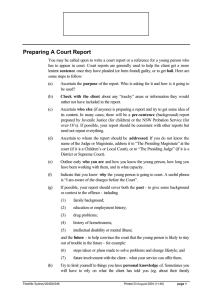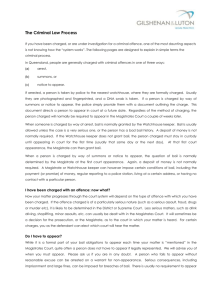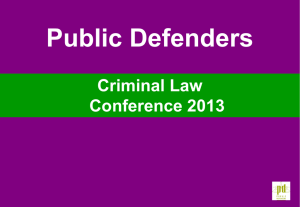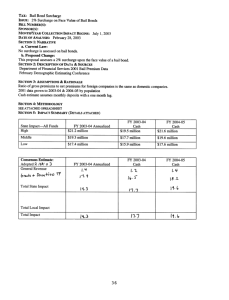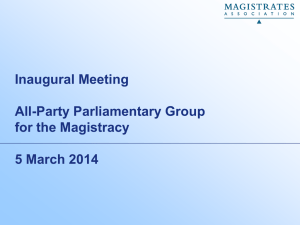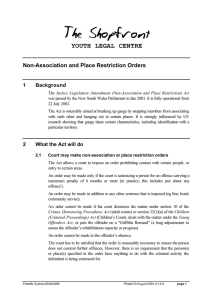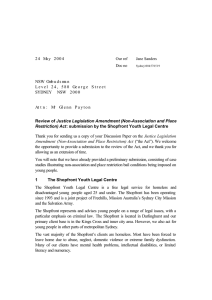YOUTH LEGAL CENTRE Court reports, references and support letters 1
advertisement
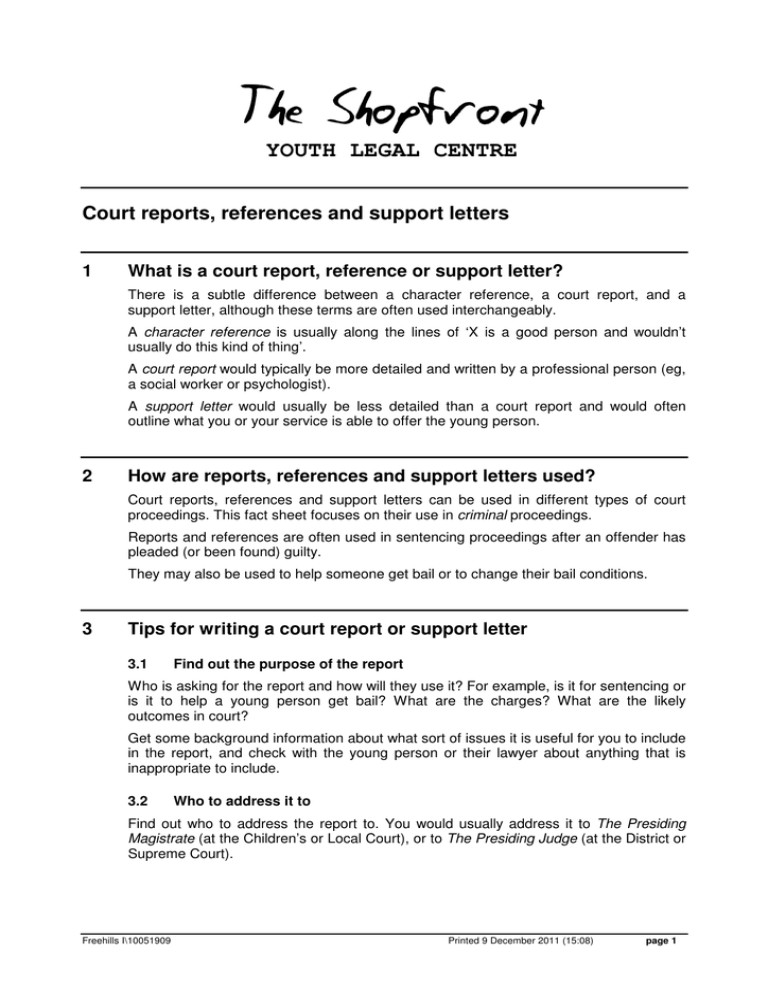
YOUTH LEGAL CENTRE Court reports, references and support letters 1 What is a court report, reference or support letter? There is a subtle difference between a character reference, a court report, and a support letter, although these terms are often used interchangeably. A character reference is usually along the lines of ‘X is a good person and wouldn’t usually do this kind of thing’. A court report would typically be more detailed and written by a professional person (eg, a social worker or psychologist). A support letter would usually be less detailed than a court report and would often outline what you or your service is able to offer the young person. 2 How are reports, references and support letters used? Court reports, references and support letters can be used in different types of court proceedings. This fact sheet focuses on their use in criminal proceedings. Reports and references are often used in sentencing proceedings after an offender has pleaded (or been found) guilty. They may also be used to help someone get bail or to change their bail conditions. 3 Tips for writing a court report or support letter 3.1 Find out the purpose of the report Who is asking for the report and how will they use it? For example, is it for sentencing or is it to help a young person get bail? What are the charges? What are the likely outcomes in court? Get some background information about what sort of issues it is useful for you to include in the report, and check with the young person or their lawyer about anything that is inappropriate to include. 3.2 Who to address it to Find out who to address the report to. You would usually address it to The Presiding Magistrate (at the Children’s or Local Court), or to The Presiding Judge (at the District or Supreme Court). Freehills I\10051909 Printed 9 December 2011 (15:08) page 1 Court reports, references and support letters 3.3 Who else is writing a report? Find out who else (if anyone) is writing a report and try to get some idea of its content. If it is for sentencing, there may be a background report prepared by Juvenile Justice or a pre-sentence report prepared by the adult Probation and Parole Service. Usually it helps if your report is consistent with other reports, but don’t repeat everything, and don’t hesitate to say something different to the official report if you have greater knowledge of your client or a different perspective. You can also put your knowledge and views about the client directly to the officer who is writing the background or pre-sentence report. With the client’s permission, contact the JJO or probation officer and let them know you can help them by providing relevant information. 3.4 How long should the report be? This depends on the purpose of the report. For busy magistrates who have to read a lot of material, short and sweet is usually best. One or two pages is a good length. However, a more detailed report may be necessary for serious matters, or if your client has significant problems worthy of detailed comment. If your report is lengthy, use headings to make it easier for the magistrate or judge to read. 3.5 Make it personal Magistrates and judges get pretty sick of seeing the same standard report again and again, with just the young person’s name changed. While it may be useful to work from a template, and while many young people’s circumstances may be depressingly similar, make sure the report conveys a sense of your client as an individual. 3.6 Only talk about what you know Try to limit yourself to things you have a personal knowledge of. Sometimes you have to rely on what the client has told you (eg, about their family background). This is OK but don’t try to pass it off as your first-hand knowledge. 3.7 Be positive, but don’t ignore the truth or make excuses Of course you will want to emphasise the positive aspects about the young person, to help them get bail or a more lenient sentence. But don’t sound like you are making excuses or justifying the offence, and don’t be afraid to raise negative points. A balanced report will have more credibility with the court. 3.8 Practicalities Put the report on your organisation’s letterhead if you have one. Remember to sign and date the report. Give the report to the young person or to their lawyer. If you are handing it to them at court, it helps to provide two copies (one for the lawyer to keep and one for the prosecutor) along with the original (to be handed up in court). If you are in court when the magistrate or judge reads the report, be prepared to answer questions if the magistrate asks you anything (although this does not happen very often). Freehills I\10051909 Printed 9 December 2011 (15:08) page 2 Court reports, references and support letters 4 What to cover in the report 4.1 Who are you? Outline early on: • who you are, including any relevant qualifications • something about the service you work for • how long you have been working with the young person and in what capacity 4.2 Make it clear that you know why the person is in court This is really important. It shows that you have made your assessment of the client in light of the current circumstances. Sometimes you may even be able to say that their behaviour in committing the offence is out of character. 4.3 Background information to put the offence in context (if the report is for sentencing) If you are preparing a report for a bail application, you would not usually go into details about the alleged offence. If you are preparing a report for sentencing, ideally it should include some information that provides some background or context to the offence. This may include: • family background • housing situation • education or employment history • any disability or health issues • alcohol and other drug problems Be sure to explain how these factors have contributed to the offence. Do not include large amounts of background information if it is not relevant – in some cases it may harm your client’s case. If in doubt, discuss this with the young person’s lawyer. 4.4 Don’t say the person denies committing the offence (if the report is for sentencing) At sentencing, your client has already pleaded guilty or the court has already found them guilty. Now isn’t the time to say they didn’t do it! This is called traversing the plea and can lead to lots of headaches at court. If your client is adamant about their innocence, you should make sure they get legal advice about appealing against the finding of guilt or withdrawing their guilty plea. 4.5 Rehabilitation and support Although the magistrate or judge may be very sympathetic about a young person’s difficult background, this will not be enough to ensure a good sentencing outcome. The court will want to see your client taking steps towards rehabilitation, so as to reduce the likelihood of re-offending. Freehills I\10051909 Printed 9 December 2011 (15:08) page 3 Court reports, references and support letters Therefore it is helpful to include comments about: • the young person’s feelings of remorse or regret for what they did • any steps they have taken or plans they have made to seek treatment, solve problems or change their lifestyle • your future involvement with the young person – what you or your organisation can offer them and how this will assist with their rehabilitation. 4.6 Factors relevant to bail (if the report is for a bail application) Before releasing someone on bail (or varying existing bail conditions), the court will want to feel confident that the person will appear in court, will not interfere with witnesses or evidence, and will not commit further offences while on bail. Your report should try to address these concerns by providing evidence that the client is reliable and/or well-supported. If you are trying to get bail conditions varied, you should include specific information about why the variation is necessary or desirable (eg, the client has a 10pm curfew but now has a job which involves working night shifts). 4.7 Suggestions and recommendations It is not your role to tell the judge or magistrate what to do. However, it is OK for you to suggest appropriate sentencing options, recommend suitable programs, and outline how you or your agency can help. Adapted from the book Youth Justice: your guide to cops and court in NSW (4th edition, 2010, published by Federation Press) The Shopfront Youth Legal Centre July 2011 The Shopfront Youth Legal Centre 356 Victoria Street Darlinghurst NSW 2010 Tel: 02 9322 4808 Fax: 02 9331 3287 www.theshopfront.org shopfront@freehills.com The Shopfront Youth Legal Centre is a service provided by Freehills, in association with Mission Australia and the Salvation Army. This document was last updated in July 2011 and to the best of our knowledge is an accurate summary of the law in New South Wales at that time. This document provides a summary only of the subject matter covered, without the assumption of a duty of care. The summary should not be relied on as a substitute for legal or other professional advice. This document may be photocopied and distributed, or forwarded by email, on the condition that the document is reproduced in its entirety and no fee is charged for its distribution. Freehills I\10051909 Printed 9 December 2011 (15:08) page 4
